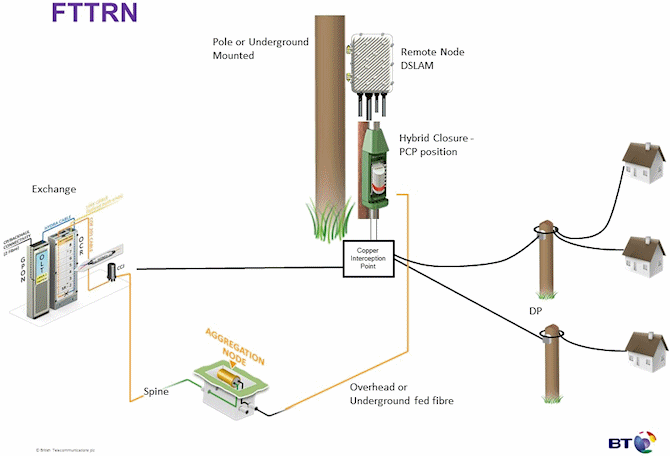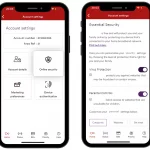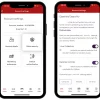UK Homes Could in Future Provide Electricity for BT’s Broadband Network
The Broadband Forum has produced a new technical specification (TR-301) that appears to lay the groundwork for future deployments of VDSL2 (FTTC) and G.fast based broadband technologies that suck the power they need directly from home users (your electricity bill might take a hit).
Regular readers will no doubt be familiar with this approach because it’s something that we’ve touched on a few times before when discussing both G.fast, VDSL2 and the related Fibre-to-the-Remote-Node (FTTrN) and Fibre-to-the-distribution-point (FTTdp) technologies.
Advertisement
At present BT’s existing up to 80Mbps FTTC service takes a fibre optic cable from the telephone exchange to your local street cabinet (your existing copper line is then used between the cabinet and homes).
By comparison FTTrN / FTTdp sees the fibre optic cable being taken to a significantly smaller Remote Node / dp (mini fibre cabinet) and these can be positioned on nearby telegraph poles, within street cabinets or inside manholes, which means they can potentially also exist even closer to homes (faster speeds).

In theory this sort of approach should work well for extending superfast (24Mbps+) and ultrafast (100Mbps+) class broadband connections into areas that are harder to reach, both in respect to rural and urban areas. BT is currently conducting various trials, which can use both VDSL2 (FTTC) style remote nodes and G.fast based nodes.
Unfortunately one of the biggest problems with expanding the use of these nodes concerns the expensive question of power supply, which was highlighted by a recent trial in North Yorkshire that saw FTTrN being used to connect around 16 premises in the tiny village of Ulshaw (here and here).
Advertisement
North Yorkshire Council Update – 18th Nov 2014
BT have now informed SFNY that the wide scale deployment of FTTRN will be delayed by up to a year. The key issue is the cost of power. The trial at Ulshaw uses a 1:1 power supply to a node that serves 16 premises. This is the same power supply that would serve a cabinet with 200 premises or more. Therefore the cost per premise of FTTRN carries a significant ‘levy’ for power compared to a Fibre to the Cabinet (FTTC) solution.
The solution for BT is to find a way of aggregating multiple FTTRN nodes to a single power supply. Until this technical problem is solved, BT are not able to offer an ‘uplift’ to the Phase 2 premises number using FTTRN.
In some areas the issue of power may be easier to solve, but it’s a complicated problem and so far the proposed approach of “aggregating multiple FTTRN nodes to a single power supply” doesn’t appear to have turned up (we’ve asked plenty of times and so far a working solution has not been implemented).
One somewhat radical alternative is the idea of adopting a Reverse Power approach, which effectively means that electricity could be sucked from your home or office supply and used to power BT’s broadband nodes. Suffice to say that the Broadband Forum are heralding this, as part of their new TR-301 specification (supporting both VDSL2 and G.fast), as a big leap forward.
Kevin Foster, Chairman of the Broadband Forum, said:
“This represents a significant amount of work over many years including often challenging global industry consensus building. This will be the global standard for this innovative access architecture, and one on which many Service Providers will build their ultra-fast aspirations. Technical Report 301 will enable the global economies of scale necessary for successful deployment of ultrafast broadband.”
Related setups would need to be robust enough to cope with isolated power cuts and to prevent other infrastructure problems from impacting upon nearby premises. Likewise it might also conceivably require some consideration by the telecoms regulator, Ofcom, given that it changes the approach to deployment in a way that could impact end-users (positively and negatively).
One of the key concerns in all this will be with your electricity bill, particularly given that an operator like BT would effectively be shifting the cost for this on to individual home owners where the price you pay for energy is likely to vary. Home owners also don’t have the same tax or economics of scale advantages that a big operator like BT has when buying power, but the impact of this might vary between locations.
Advertisement
The cost would of course depend upon how much electricity the node needs to suck and for this the ECI MiniCab 64V might offer an example. The node is able to serve 64 VDSL2/ADSL2+ subscribers and has a maximum power consumption of 170 Watts (shared between premises), although quite how this might play out in the real-world is more difficult to know.
On the slip side if you live in a poorly served rural area then the idea of paying more on your electricity bill in order to get superfast or even ultrafast broadband service might just be enough to out-way some of the potential disadvantages, but we suspect that many consumers wouldn’t want to have this approach imposed upon them without a choice. At the very least BT would also need to reduce the price of the service itself in order to compensate for the shifted power responsibility.
So when might this happen? BT appear to be one of the operators supporting the Broadband Forum’s new specification, but so far we haven’t seen any sign of a Reverse Power approach being trialled in the UK (at least not in a real-world community) and that’s not surprising given the obvious concerns. Never the less there may be some areas that would welcome such an approach with open arms.
Mark is a professional technology writer, IT consultant and computer engineer from Dorset (England), he also founded ISPreview in 1999 and enjoys analysing the latest telecoms and broadband developments. Find me on X (Twitter), Mastodon, Facebook, BlueSky, Threads.net and Linkedin.
« Unpaid Contractors Cast Shadow Over Fibre Garden’s Cumbria FTTP Rollout


















































Comments are closed